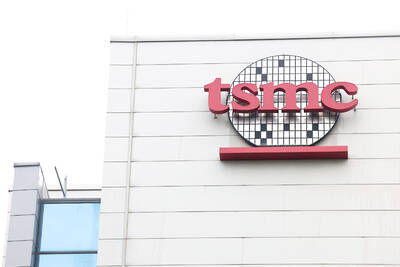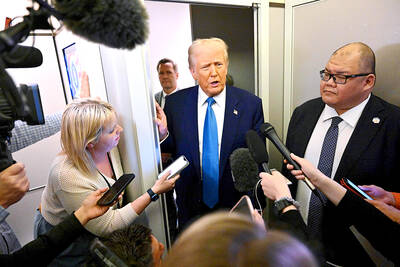US planemaker Boeing Co raised its industry-wide annual 20-year forecast for new jetliner deliveries by 3 percent to 43,975, propelled by the strength of passenger demand, rising airline competition and the eventual replacement of older less efficient planes.
Boeing, which updated its forecast on the eve of the Farnborough Air Show outside London that opens today, said airlines would need a rising number of planes through 2043.
Boeing vice president of commercial marketing Darren Hulst said the retirement rates of older airplanes dropped in half over the past four years “because of the lack of aircraft coming into the market.”

Photo: Reuters
He said that issue would get addressed in the medium to long-term as supply constraints ease.
Single-aisle airplanes would account for 33,380 deliveries — or 76 percent of forecasted demand. Deliveries from now until 2043 are also expected to include 8,065 widebody planes, 1,525 regional jets and 1,005 freighters, Boeing said.
About half of new jet deliveries would replace older models, while the other half would grow airlines’ fleets, Boeing added.
The global aircraft fleet would almost double over the next 20 years, from about 26,750 jets last year to 50,170 by 2043, Boeing said.
The company also raised its industry-wide passenger traffic forecast growth rate to 4.7 percent.
Aviation was hit hard by the COVID-19 pandemic, which saw air travel collapse only to bounce back sharply. That has left many firms scrambling to resolve labor and parts shortages, and other supply chain issues. Manufacturers like Boeing and Airbus SE are struggling to keep up with significant demand and airlines face multi-year waits to get new airplanes.

When an apartment comes up for rent in Germany’s big cities, hundreds of prospective tenants often queue down the street to view it, but the acute shortage of affordable housing is getting scant attention ahead of today’s snap general election. “Housing is one of the main problems for people, but nobody talks about it, nobody takes it seriously,” said Andreas Ibel, president of Build Europe, an association representing housing developers. Migration and the sluggish economy top the list of voters’ concerns, but analysts say housing policy fails to break through as returns on investment take time to register, making the

‘SILVER LINING’: Although the news caused TSMC to fall on the local market, an analyst said that as tariffs are not set to go into effect until April, there is still time for negotiations US President Donald Trump on Tuesday said that he would likely impose tariffs on semiconductor, automobile and pharmaceutical imports of about 25 percent, with an announcement coming as soon as April 2 in a move that would represent a dramatic widening of the US leader’s trade war. “I probably will tell you that on April 2, but it’ll be in the neighborhood of 25 percent,” Trump told reporters at his Mar-a-Lago club when asked about his plan for auto tariffs. Asked about similar levies on pharmaceutical drugs and semiconductors, the president said that “it’ll be 25 percent and higher, and it’ll

NOT TO WORRY: Some people are concerned funds might continue moving out of the country, but the central bank said financial account outflows are not unusual in Taiwan Taiwan’s outbound investments hit a new high last year due to investments made by contract chipmaker Taiwan Semiconductor Manufacturing Co (TSMC, 台積電) and other major manufacturers to boost global expansion, the central bank said on Thursday. The net increase in outbound investments last year reached a record US$21.05 billion, while the net increase in outbound investments by Taiwanese residents reached a record US$31.98 billion, central bank data showed. Chen Fei-wen (陳斐紋), deputy director of the central bank’s Department of Economic Research, said the increase was largely due to TSMC’s efforts to expand production in the US and Japan. Investments by Vanguard International

WARNING SHOT: The US president has threatened to impose 25 percent tariffs on all imported vehicles, and similar or higher duties on pharmaceuticals and semiconductors US President Donald Trump on Wednesday suggested that a trade deal with China was “possible” — a key target in the US leader’s tariffs policy. The US in 2020 had already agreed to “a great trade deal with China” and a new deal was “possible,” Trump said. Trump said he expected Chinese President Xi Jinping (習近平) to visit the US, without giving a timeline for his trip. Trump also said that he was talking to China about TikTok, as the US seeks to broker a sale of the popular app owned by Chinese firm ByteDance Ltd (字節跳動). Trump last week said that he had